All-On-4 Dental Implants
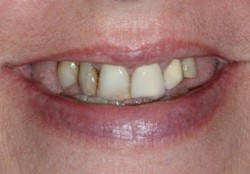 Worn Out Teeth + Partials
Worn Out Teeth + Partials
Full arch reconstruction for one or both jaws has the greatest appeal for patients who have lost the majority of their teeth and experience tooth replacement complications due to bone loss. The largest patient group in terms of sheer numbers are denture wearers or patients with partials. Partials, like dentures, will cause some degree of bone loss. The removal of teeth ceases stimulation of bone. How much bone is lost with the use of partials is very different for each patient. Some patients are fitted with precision partials and have excellent dental function and bite. Others who have had poor performance and fit of a denture partial will often times keep using a poor-fitting partial because of frustration and/or cost issues. Loose, rocking, pinching or otherwise uncomfortable partials can accelerate the loss of bone density.
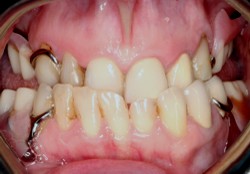 Upper Jaw Implant Guide
Upper Jaw Implant Guide
The sequence of photos shown in this treatment example are of a female who sustained considerable loss of dental function and posterior bone in the upper and lower jaws. An unusual bite eventually developed, mimicking s severe orthodontic underbite issue, as seen in the adjacent photo. Frustrated with multiple experiences of cosmetic and functional dental failure, this young woman elected to use the Nobel Biocare treatment protocols that would recreate what she once had with premium grade implants, effective surgical procedures, and prosthetics.
The All-on-Four protocol assures patients of precision implant placement that takes the best advantage possible of healthy bone. It generates a computerized design of a prosthetic that rebuilds the dental function of a given arch with a normalization of lost bite height (vertical dimension) that typically accompanies long term denture use.
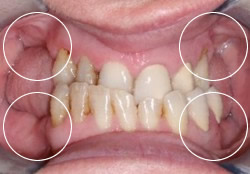 Bone Loss Degradation in 4 Quadrants
Bone Loss Degradation in 4 Quadrants
Long Term Use of Partials
For this patient, her All-on-Four treatment plan enabled Dr. Petulla to minimize the need for bone block grafting in the deficient areas. Specific sizes of implants (diameter and height) were used to form a rock solid foundation in both the maxilla and mandible for a bite strength she hasn't enjoyed since her early adult years. The calculated distribution of her renewed biting forces assures that all supporting bone structures will be healthfully maintained with little concern for overloading a particular implant.
Implant Placements
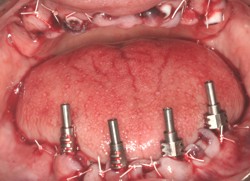 Lower - Upper Jaw Implants
Lower - Upper Jaw Implants
The adjacent photo reflects the placement of 4 mandibular implants (alignment guide pins showing) and 4 maxillary implants. Selective use of tissue grafting products are used to fortify each implant site, along with the need to "plump up" gum tissues. The next photo is a close-up view of the upper arch, showing locations of each implant site and periodontal surgeries that will heal into a nicely formed upper ridge of bone.
The All-on-Four procedure can be used for patients who do not have bone loss or significant tooth loss issues. As with many of our procedures, it is used in combination with prosthetic teeth to create tooth replacement options for patients who seek treatment standards that are recognized internationally, and have longevity that is second to none.
Bite Height - Cosmetic Face Lift
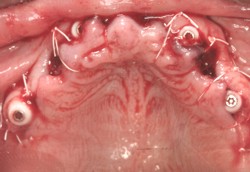 Upper Arch Close Up View
Upper Arch Close Up View
Periodontal Suturing - Four Implants
The loss of bone that normally occurs from long term use of denture products creates what we all recognize as "granny mouth." The mouth over-closes, creating an effect where the chin appears to get closer and closer to the nose. The removal of upper and lower dentures in a denture patient over-dramatizes this effect. Understandably, a collapsed bite is associated with aging. All-on-Four dentistry reverses the aging effect of a collapsed bite. The design and fabrication of the upper and lower prosthetics incorporate numerical values necessary for recreation of the patient's original bite height, given her facial characteristics.
CT Scans: Planning and Fabrication
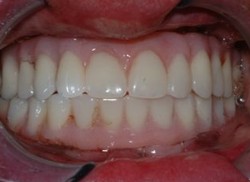 New Teeth - Bite - Function
New Teeth - Bite - Function
Collapsed Bite Correction
The advantage of CAD/CAM 3 Dimensional scanning and treatment planning is that it creates a system of prosthetic attachment and aesthetic design that is, for practical purposes, unsurpassed in reconstructive dentistry. The adjacent, over-retracted picture of the patient's new teeth provides a view of how prosthetic teeth and gingival areas are created. This offers the confidence that the patient's new smile will reveal nothing but teeth and gum tissue that looks and feels as natural as Mother Nature's own handiwork.
Questions?
Bioengineering, CT scans, CAD/CAM design, and advancements in tissue and teeth replacement materials create multiple tooth replacement and restoration choices for our patients. If you have unique treatment needs, or questions about financing your dental treatment, contact Dr. Petulla or Dr. Kazemi directly with our on-line Ask the Dentist form. Questions regarding the material, pictures, or Nobel Biocare procedures outlined on this page can also be discussed further during a consultation. Call us to arrange an appointment or use our convenient Appointment Request form.
